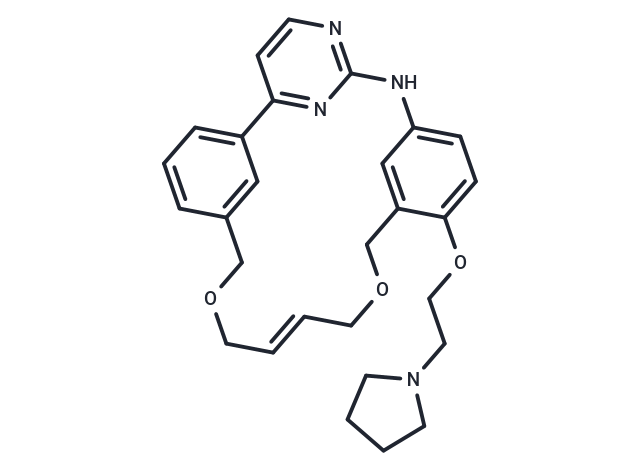Shopping Cart
- Remove All
 Your shopping cart is currently empty
Your shopping cart is currently empty

Pacritinib (SB1518) (SB1518) is an effective and specific inhibitor of JAK2 and FLT3 (IC50: 23/22 nM, in cell-free assays).

| Pack Size | Price | Availability | Quantity |
|---|---|---|---|
| 2 mg | $34 | In Stock | |
| 5 mg | $55 | In Stock | |
| 10 mg | $89 | In Stock | |
| 25 mg | $153 | In Stock | |
| 50 mg | $239 | In Stock | |
| 100 mg | $396 | In Stock | |
| 500 mg | $929 | In Stock |
| Description | Pacritinib (SB1518) (SB1518) is an effective and specific inhibitor of JAK2 and FLT3 (IC50: 23/22 nM, in cell-free assays). |
| Targets&IC50 | JAK3:520 nM |
| In vitro | Pacritinib is an effective inhibitor of both wild-type JAK2 and JAK2V617F mutant (IC50: 19 nM). The IC50s of Pacritinib are 50 nM for TYK2, 520 nM for JAK3 and 1280 nM for JAK1. Pacritinib effectively permeates cells to modulate signaling pathways downstream of JAK2, whether agonist activated or mutationally activated. Pacritinib induces apoptosis, cell cycle arrest and antiproliferative effects in JAK2WT- and JAK2V617F-dependent cells. Pacritinib inhibits cell proliferation of Karpas 1106P (IC50: 348 nM ) and Ba/F3-JAK2V617F (IC50: 160 nM ), respectively. Pacritinib inhibits endogenous colony growth derived from erythroid (IC50: 63 nM) and myeloid progenitors(IC50: 53 nM), respectively.[1] SB1518 also inhibits FLT3 and its mutant FLT3-D835Y (IC50: 6 nM ). Pacritinib inhibits FLT3 phosphorylation and downstream STAT, MAPK and PI3K signaling in FLT3-internal-tandem duplication (ITD), FLT3-wt cells and primary AML blast cells. Pacritinib treatment leads to a dose-dependent decrease of pFLT3, pSTAT5, pERK1/2 and pAkt in FLT3-ITD harboring MV4-11 cells with IC50 of 80, 40, 33 and 29 nM , respectively. Treatment of the primary AML blast cells with Pacritinib for 3 h leads to a dose-dependent decrease of pFLT3, pSTAT3 and pSTAT5 with an IC50 below 0.5 μM. Pacritinib induces apoptosis, cell cycle arrest and anti-proliferative effects in FLT3-mutant and FLT3-wt cells. Pacritinib inhibits cell proliferation of FLT3-ITD-harboring cells MV4-11 (IC50: 47 nM ) and primary AML blast (IC50: 0.19-1.3 nM ) cells. |
| In vivo | In JAK2V617F-dependent xenograft model, Pacritinib (150 mg/kg, p.o., q.d.) markedly ameliorates splenomegaly and hepatomegaly symptoms, with 60% normalization of spleen weight and 92% normalization of liver weight and is well tolerated without significant weight loss or any hematological toxicities, including thrombocytopenia and anemia. In JAK2V617F-dependent SET-2 xenograft model, Pacritinib dose-dependent inhibits tumor growth (40% for 75 mg/kg and 61% for 150 mg/kg).[1] Pacritinib treated once daily for 21 consecutive days, induces dose-dependent inhibition of tumor growth (38% for 25 mg/kg, 92% for 50 mg/kg and 121% for 100 mg/kg). Complete regression is observed in 3/10 and 8/8 mice for the 50 and 100 mg/kg/day groups, respectively. |
| Kinase Assay | kinase activity assays: All assays are carried out in 384-well white microtiter plates. Compounds are 4-fold serially diluted in 8 steps, starting from 10 μM. The reaction mixture consisted of 25 μL assay buffer (50 mM HEPES pH 7.5, 10 mM MgCl2, 5 mM MnCl2, 1 mM DTT, 0.1 mM Na3VO4, 5 mM β-glycerol phosphate). For FLT3 assays, the reaction contains 2.0 μg/mL FLT3 enzyme, 5 μM of poly(Glu,Tyr) substrate and 4 μM of ATP. For JAK1 assays, the reaction contains 2.5 μg/mL of JAK1 enzyme, 10 μM of poly(Glu,Ala,Tyr) substrate and 1.0 μM of ATP. For JAK2 assays, the reaction contained 0.35 μg/mL of JAK2 enzyme, 10 μM of poly (Glu,Ala,Tyr) substrate and 0.15 μM of ATP. For JAK3 assays, the reaction contained 3.5 μg/mL of JAK3 enzyme, 10 μM of poly (Glu,Ala,Tyr) substrate and 6.0 μM of ATP. For TYK2 assays, the reaction contained 2.5 μg/mL of TYK2 enzyme, 10 μM of poly (Glu,Ala,Tyr) substrate and 0.15 μM of ATP. The reaction is incubated at room temperature for 2 h prior to addition of 13 μL PKLight? detection reagent. After 10 min incubation luminescent signals are read on a multi-label plate reader. |
| Cell Research | Cells are seeded at 30-50% confluency in 96-well plates and are treated with different concentrations of compounds (in triplicate) for 48 h. Cell viability is monitored using the CellTiter-Glo assay.(Only for Reference) |
| Alias | SB1518 |
| Molecular Weight | 472.58 |
| Formula | C28H32N4O3 |
| Cas No. | 937272-79-2 |
| Smiles | C(CN1CCCC1)Oc1ccc2Nc3nccc(n3)-c3cccc(COC\C=C\COCc1c2)c3 |
| Relative Density. | 1.22 g/cm3 (Predicted) |
| Storage | Powder: -20°C for 3 years | In solvent: -80°C for 1 year | Shipping with blue ice. | ||||||||||
| Solubility Information | H2O: < 1 mg/mL (insoluble or slightly soluble) Ethanol: < 1 mg/mL (insoluble or slightly soluble) DMSO: 1 mg/mL (2.12 mM), Sonication is recommended. | ||||||||||
Solution Preparation Table | |||||||||||
DMSO
| |||||||||||

Copyright © 2015-2025 TargetMol Chemicals Inc. All Rights Reserved.